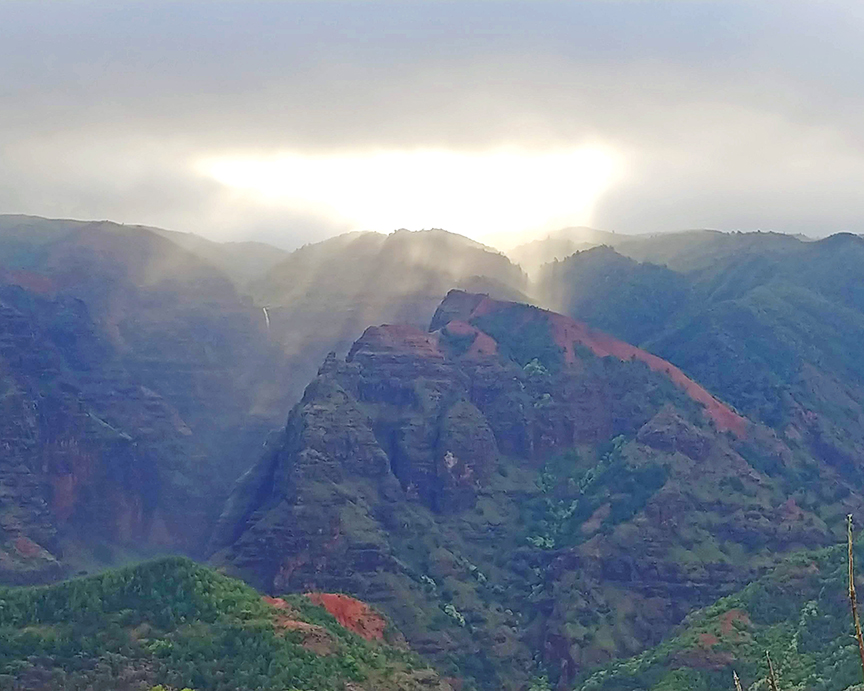
Project Imua team members at the launchpad. The rocket with the Project Imua payload is in the background. From left: Co-Principal Investigator and Mentor Gregory Witteman (Honolulu CC); Mitch Mikami (Kapi‘olani CC); Madori Rumpungworn (Windward CC); Suraj Mehta (Honolulu CC); Keith Nakamatsu (Windward CC); Co-Principal Investigator and Mentor Georgeanne Purvinis (Kaua‘i CC); Cale Mechler (Windward CC); Marcus Yamaguchi (Kaua‘i CC); Brennen Sprenger (Kaua‘i CC); Nick Herrmann (Kaua‘i CC). Photo courtesy of UH
University of Hawaiʻi community college students watched their scientific payload spin into space Aug. 12 when a two-stage Terrier-Improved Malemute sounding rocket was launched around midnight Hawaiʻi time from NASA’s Wallops Flight Facility in Virginia.
Students from Kauaʻi Community College, Honolulu Community College, Kapiʻolani Community College and Windward Community College are part of a collaboration known as Project Imua, a joint faculty-student enterprise for designing, fabricating and testing payloads.
“This is really a system-wide collaboration, an effort to bring new industry and new technology into the Hawaiʻi economy,” said Marcus Yamaguchi, as student at Kauaʻi Community College in Puhi.
The UH team was the only community college team whose payload was selected for this launch. Payloads developed by students from seven higher education programs were aboard the rocket.
Other KCC members of the Project Imua team included students Brennen Sprenger, Amber Mokelkea and Nick Herrmann, and project mentors Georgeanne Purvinis and Stu Burley.

A two-stage Terrier-Improved Malemute sounding rocket launched on August 12, 2015. Photo courtesy of UH
“You just see the thing ignite and shoot off into the sky. It’s the most amazing feeling in the world, especially since we’ve been working on it for over a year. And we are finally seeing all of our hard work pay off,” Kapiʻolani Community College student Kalaʻimoana Garcia said.
The scientific instrument that forms the main component of Project Imua’s payload consists of a UV spectrometer that will analyze the intensity of the sun’s ultraviolet radiation before it enters Earth’s atmosphere. The data could have implications regarding climate.
“It’s been a long trip. It’s taken nine months to get here, so its really exciting that we are finally getting a launch that’s going to be the culmination of what we’ve been working for,” Windward Community College student Cale Mechler said.
After achieving an altitude of 94 miles, plans were for the payload with the students’ experiments to be recovered in the Atlantic Ocean off the Virginia coast. The experiments and any stored data would then be provided to the teams to analyze.
“We can do anything just like anywhere else in the world. We have facilities and we have come so far. Project Imua means to move forward and we have definitely moved forward,” Honolulu Community College student Suraj Mehta said.
About Project Imua
Project Imua is funded by a two-year $500,000 grant awarded under the NASA Space Grant Competitive Opportunity for Partnerships with Community Colleges and Technical Schools. Project Imua is supported by UH Mānoa, UH’s main Hawaiʻi Space Grant Consortium campus, which provides technical assistance through Hawaiʻi Space Flight Laboratory’s resources and personnel.
Discover more from For Kauai Online
Subscribe to get the latest posts to your email.






Leave a Reply